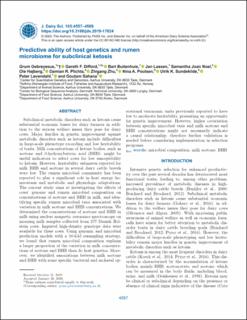| dc.description.abstract | Subclinical metabolic disorders such as ketosis cause substantial economic losses for dairy farmers in addition to the serious welfare issues they pose for dairy cows. Major hurdles in genetic improvement against metabolic disorders such as ketosis include difficulties in large-scale phenotype recording and low heritability of traits. Milk concentrations of ketone bodies, such as acetone and β-hydroxybutyric acid (BHB), might be useful indicators to select cows for low susceptibility to ketosis. However, heritability estimates reported for milk BHB and acetone in several dairy cattle breeds were low. The rumen microbial community has been reported to play a significant role in host energy homeostasis and metabolic and physiologic adaptations. The current study aims at investigating the effects of cows' genome and rumen microbial composition on concentrations of acetone and BHB in milk, and identifying specific rumen microbial taxa associated with variation in milk acetone and BHB concentrations. We determined the concentrations of acetone and BHB in milk using nuclear magnetic resonance spectroscopy on morning milk samples collected from 277 Danish Holstein cows. Imputed high-density genotype data were available for these cows. Using genomic and microbial prediction models with a 10-fold resampling strategy, we found that rumen microbial composition explains a larger proportion of the variation in milk concentrations of acetone and BHB than do host genetics. Moreover, we identified associations between milk acetone and BHB with some specific bacterial and archaeal operational taxonomic units previously reported to have low to moderate heritability, presenting an opportunity for genetic improvement. However, higher covariation between specific microbial taxa and milk acetone and BHB concentrations might not necessarily indicate a causal relationship; therefore further validation is needed before considering implementation in selection programs. | |
